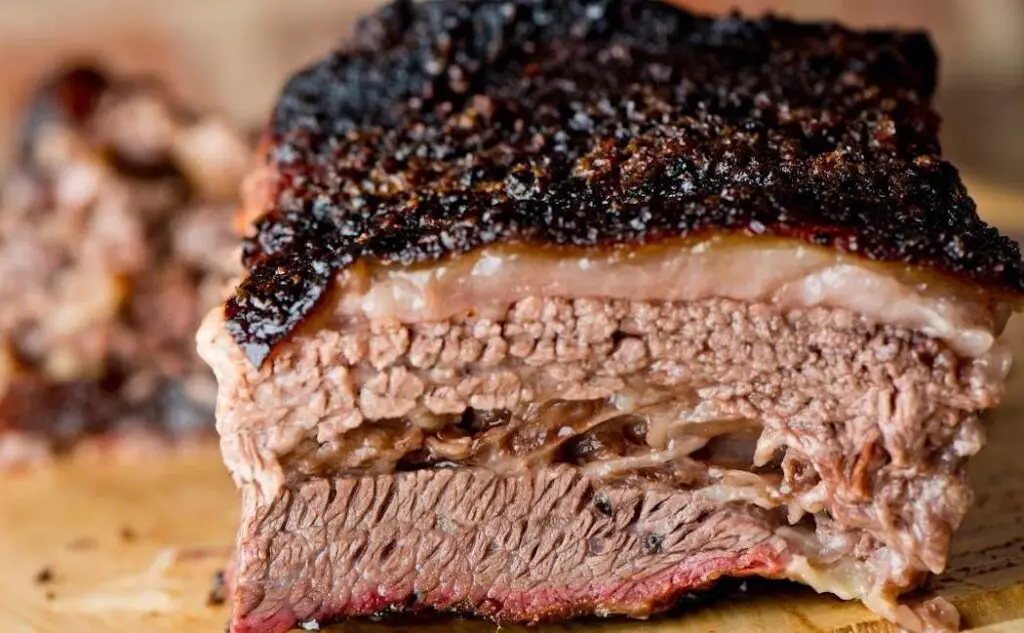
If you need a brisket in a hurry, you can fire up your Traeger and knock one out a brisket in half the time. A hot and fast brisket can taste surprisingly good even though the meat is exposed to such high temperatures. A brisket cooked at high temps breaks all the rules, but if you know the rules, you can break them. In this article, I’ll show you how the pros approach the hot and fast brisket on a Traeger, from the preparation to the cook.
To cook a hot and fast brisket on a Traeger, set the temperature between 350°F to 400°F and fill the hopper. Place the brisket in the Traeger with the brisket point facing the hottest part of the grill. Cook for 1.5 to 2 hours, then remove the brisket and wrap it in foil or butcher paper. Return the wrapped brisket to the Traeger and insert a thermometer probe into the middle. Cook until the internal temperature reaches around 195°F, checking the temperature every 10 minutes. Once the brisket reaches 203°F and is tender, remove it from the Traeger. Allow the brisket to rest for at least one hour in a dry cooler, then slice against the grain. Prior to cooking, choose a brisket with even fat coverage and as much marbling as you can afford. Trim the fat cap to 1/4 inch and brine the brisket with kosher or sea salt for at least 2 hours before cooking. Use a rub with low salt content if you are pre-salting the meat.
Traeger Hot-and Fast Brisket Recipe: Step-by-Step
| Step | Hot-and-Fast Brisket |
|---|---|
| 1 | Set temperature of Traeger between 350°F to 400°F |
| 2 | Fill hopper and remove water pan |
| 3 | Place brisket on Traeger, with point facing hottest part of grill |
| 4 | Cook for 1.5-2 hours |
| 5 | Wrap brisket in foil or butcher paper |
| 6 | Return wrapped brisket to Traeger and insert thermometer probe |
| 7 | Cook until internal temperature reaches 195°F |
| 8 | Check internal temperature every 10 minutes, remove when it reaches 203°F and is tender |
| 9 | Allow brisket to rest for at least 1 hour in a dry cooler, 2-4 hours preferable |
| 10 | Slice against the grain |
| 11 | Choose brisket with even fat covering and as much marbling as possible |
| 12 | Trim fat cap, leaving 1/4 inch |
| 13 | Brine by sprinkling with kosher salt or sea salt and refrigerate for at least 2 hours |
| 14 | Use rub with caution if pre-salting meat with dry brine |
What Temperature Do You Cook a Hot-and-Fast Brisket?
- Set temperature between 350°F and 400°F
- Do not use a water pan
- Make sure pellet hopper is full
- High heat may cause you to burn through more wood pellets
To cook a brisket hot-and-fast on a pellet grill, set the temperature of your Traeger between 350°F and 400°F. A water pan is normally recommended, but you don’t need one when cooking a hot-and-fast brisket. This is because a water pan can make it difficult for the pellet grill to maintain a consistent temperature. Also, make sure the pellet hopper is full before beginning to cook, as the high heat may cause you to burn through more wood pellets than you would at lower temperatures.
How Long Does a Hot-and-Fast Brisket Take to Cook?
- Total cook time at 400°F: 4 hours
- Total cook time at 350°F: 5 hours
- Allow at least 1 hour (preferably 2-4 hours) for resting in a dry cooler after cooking
The total cook time for a full brisket cooked hot-and-fast will depend on the cooking temperature. If you cook at 400°F, you can expect the cook time to be around 4 hours. If cooking at a lower temperature, around 350°F, the total cook time will take close to 5 hours.
When planning the cook, remember to factor in resting time. After the brisket has finished cooking, it is recommended to allow it to rest in a dry cooler for at least 1 hour, although a resting time of 2-4 hours is even better. This allows the juices to redistribute and the meat to become more tender.
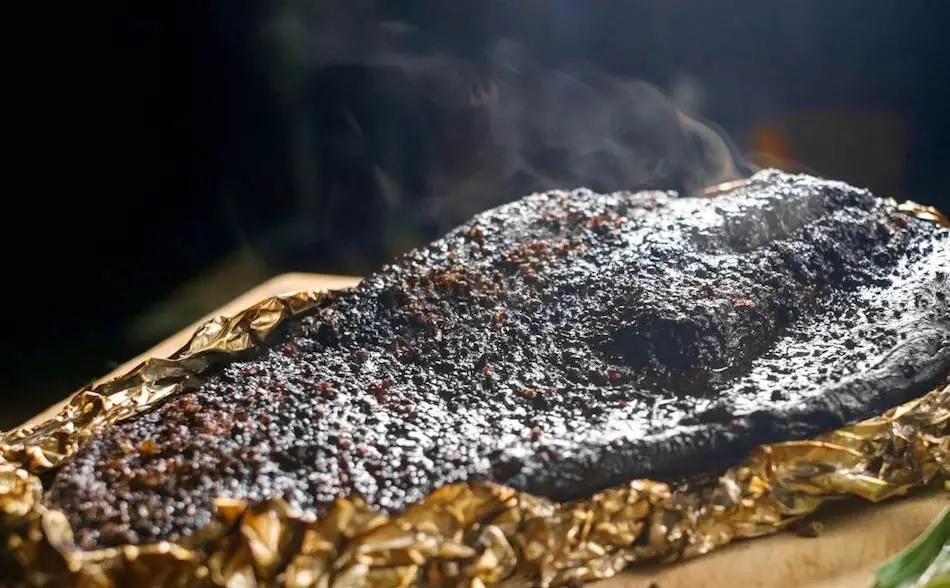
Does a Brisket Cooked Hot-and-Fast Taste Any Good?
- Hot and fast brisket will not be as flavorful or tender as low and slow cooked brisket
- Slow cooked brisket:
- Rendered fat and connective tissue
- Crusty bark
- Absorbs smoke for smoky flavor
- Juicy and tender
- Hot and fast cooked brisket breaks traditional cooking rules but can still taste good
Although a hot and fast cooked brisket will not have the same depth of flavor and tenderness as a low and slow cooked brisket, it can still be delicious if you do everything else right.
A slow cooked brisket is a labor of love. The low cooking temperature allows the fat and connective tissue to render and the outer layer of the meat to form a crusty bark. The long cooking time also gives the meat the opportunity to absorb smoke, which imparts a wonderful smoky flavor. Also, the low temperature helps the brisket to retain moisture, resulting in a juicy and tender meat.
A hot and fast cooked brisket breaks all the rules of traditional brisket cooking, but this does not necessarily mean it will not taste good. If you buy a well marbles brisket.
A Hot-and-Fast Has Less Smoke Flavor
- Hot and fast brisket will only absorb smoke for 2 hours
- Low and slow brisket will absorb smoke for 6-7 hours before wrapping stage
- Hot and fast brisket wrapped for 2 hours
- Less smoke flavor on hot and fast brisket
One key difference between hot and fast cooked brisket and low and slow cooked brisket is the amount of smoke flavor that is imparted on the meat. A hot and fast brisket will only spend about 2 hours absorbing smoke, while a low and slow brisket cooked at 220°F will spend upwards of 6 or 7 hours absorbing smoke before it reaches the wrapping stage.
Also, a hot and fast brisket will be wrapped for 2 hours, while a low and slow brisket may be wrapped for a longer period of time. This means that the hot and fast brisket will not be as smokey as the low and slow cooked brisket. If you are not a fan of strong smoke flavor, this may not be a problem for you, as the smoke flavor on a hot and fast brisket will still be present, but it will be less prominent.
The Best Wood for Smoking Brisket
- Use strong smoking wood pellets for hot and fast brisket (e.g. hickory, mesquite)
- Mild wood pellets (e.g. apple, cherry) may not provide enough smoke flavor in 2 hours
- Mesquite can make meat taste bitter if exposed to smoke for too long, but useful for short cooking time
When selecting wood pellets for a hot and fast cooked brisket on your Traeger grill, choose a wood that will give the brisket a strong smoke flavor in a short cooking time. Hickory and mesquite are both good options for this purpose, as they are known for their strong, distinctive smoke flavors.
Brisket and hickory are also a classic pairing, so hickory pellets can be a particularly good choice. On the other hand, some of the milder wood flavors, such as apple or cherry, may not provide enough smoke flavor within the 2 hour cooking time of a hot and fast brisket.
Mesquite is another option to consider, although it can make the meat taste bitter if it is exposed to mesquite smoke for too long. However, mesquite can be useful when you want a strong smoke flavor in a shorter cooking time.
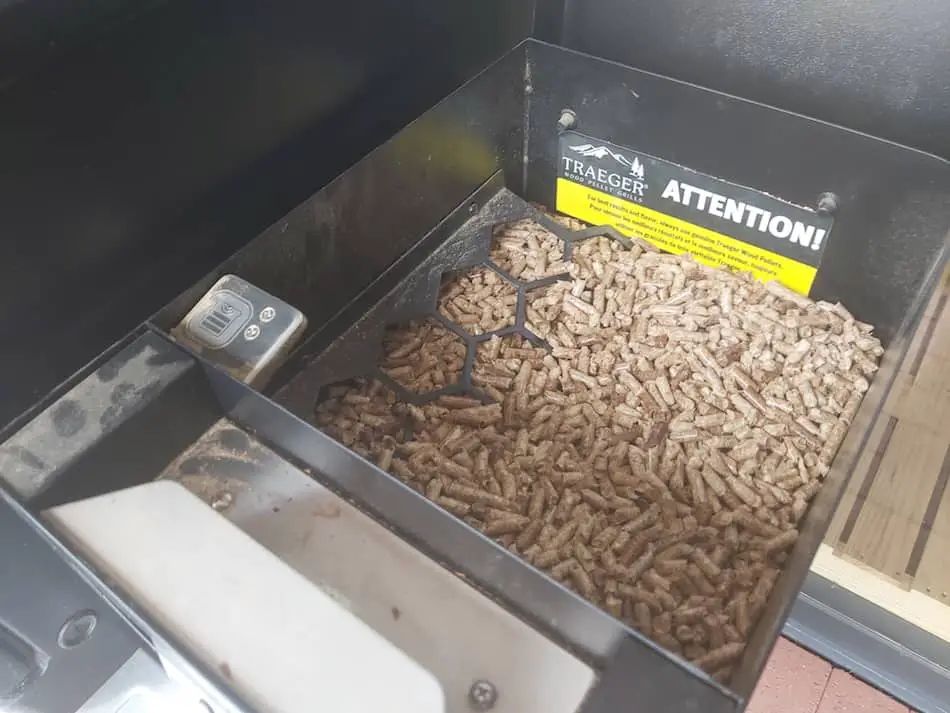
A Hot-and-Fast Brisket isn’t as Tender
- Tenderness may not be as high in hot and fast brisket
- Low heat and long cooking time needed to break down intermuscular tissue
- Hot and fast brisket flat will taste similar to low and slow, but point may taste different due to fatty connective tissue
When cooking a brisket using the hot and fast method, it is important to keep in mind that you may not achieve the same level of tenderness as you would with a low and slow cooked brisket. Brisket has a lot of fatty connective tissue, which can make it chewy if not cooked properly. To break down this intermuscular tissue and achieve a tender, juicy meat, the brisket needs to be cooked at a low heat for a long period of time. This allows the fat and connective tissue to render, resulting in a juicy, meltingly tender brisket.
While the brisket flat on a hot and fast cooked brisket may taste similar to a low and slow cooked brisket, the brisket point may taste different due to the high concentration of fatty connective tissue in this area.
A Hot-and Fast Brisket isn’t as Juicy
- Low and slow cooking helps brisket retain moisture
- Wrap brisket to hold in moisture and protect from heat
- Brine and inject liquid to increase juiciness of hot and fast brisket
One of the key principles of smoking brisket s moisture retention. High temperatures can cause the moisture in the meat to escape, leading to a dry, tough brisket. To avoid this, most pitmasters will wrap their brisket during the second half of the cook in order to hold in the moisture and protect it from overexposure to heat. This helps to ensure that the brisket remains juicy and tender.
There are a couple of other techniques you can use to help increase the juiciness of your hot and fast cooked brisket. Dry brining the brisket prior to smoking can help to add moisture to the meat, and injecting liquid directly into the brisket can also help to keep it juicy.
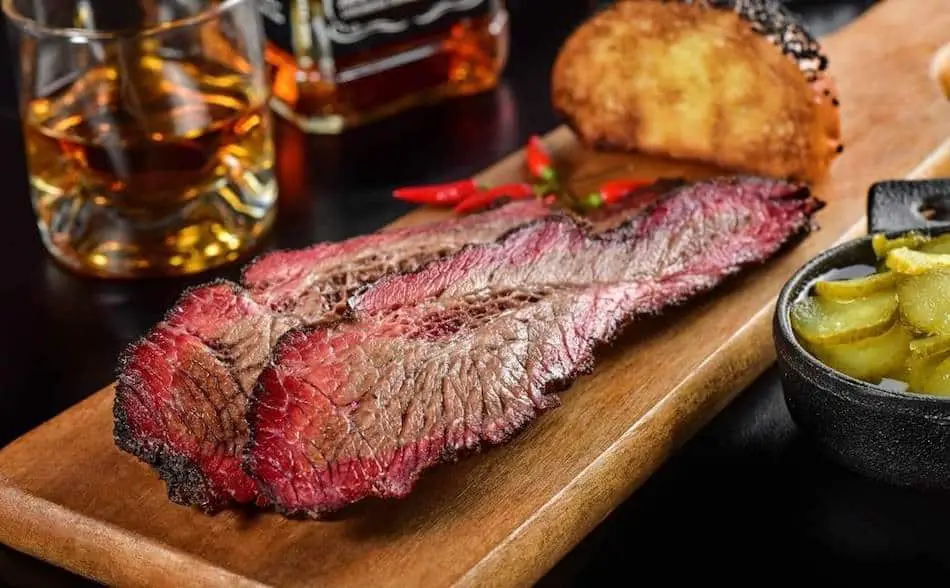
Dry Brine the Brisket Prior to Smoking
- Brining involves adding salt to the meat
- Dry brine is most suitable for brisket
- Salt helps to add flavor and moisture to brisket
- Dry brine for a few hours or overnight for best results
Brining is a technique that involves adding salt to the meat in order to add flavor and moisture. While some meats are soaked in a wet brine, this is not suitable for brisket unless you are making corned meat.
The easiest way to brine brisket is to use a dry brine, which simply involves sprinkling salt over the surface of the meat. You can use either kosher salt or sea salt for this purpose. Allowing the salt to work its way into the meat by dry brining for at least a few hours before cooking can help to enhance the flavor and moisture content of the brisket.
For even better results, you can dry brine the brisket overnight. This will give the salt plenty of time to penetrate the meat and add flavor and moisture. If you want more information on how to brine, check out this article I wrote a while back: Should I Brine Brisket?
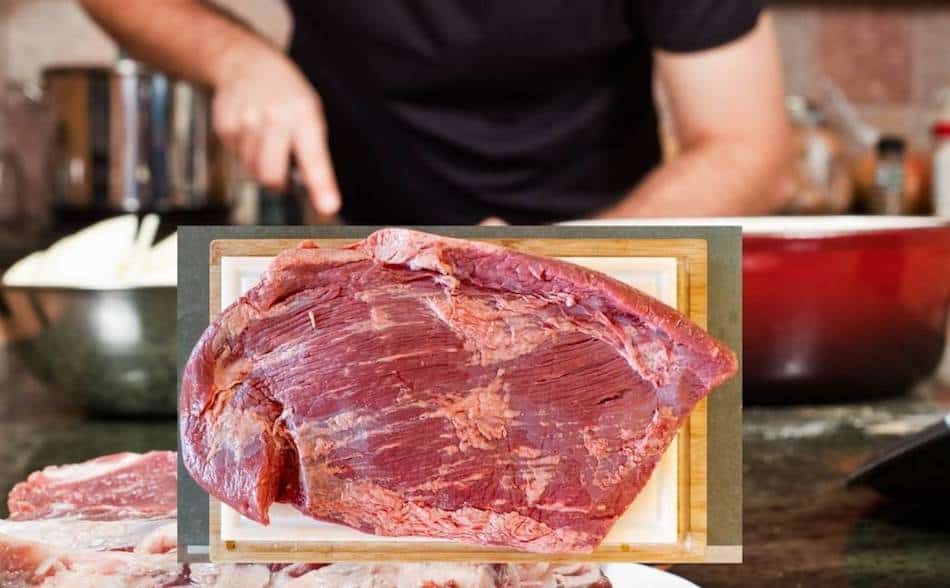
Inject the Brisket for Extra Moisture and Flavor
- Injecting fluid into brisket helps to replace lost moisture and add flavor
- Use broth or marinade for injection
- Meat injector can be purchased for around $30 on Amazon
- Injectors easy to use and can improve barbecue results
A hot and fast cooked brisket will lose a lot of moisture during the cooking process, so injecting some extra fluid into the meat can help to replace some of this lost liquid and improve the overall juiciness of the brisket.
There are a few different options for injecting fluid into the brisket, including using broth or a marinade. If you have a meat injector, this is an easy way to pump the fluid into the meat, but if you do not have an injector, they can be easily purchased online for around $30. Injectors are simple to use and can add a lot of flavor to the meat, taking your barbecue to the next level. I’ve written a full article on injecting brisket where I go into greater depth: Should I Inject Brisket?
The Bark on Hot-and-Fast Brisket
- Bark texture may be different on hot and fast brisket
- Low and slow cooking allows for formation of bark
- Hot and fast cooking does not have time for bark to form
- Rub may not fuse with meat on hot and fast brisket
One noticeable difference between a low and slow cooked brisket and a hot and fast cooked brisket is the texture of the bark, or the outer layer of the meat. The bark on a brisket takes time to develop, and a low and slow cooked brisket cooked at 220°F will have around 6 or 7 hours to form the bark before it is wrapped.
On the other hand, a hot and fast cooked brisket will not have as much time for the bark to form, resulting in a different texture. You may notice that the bark on a hot and fast cooked brisket falls away easily when touched, as the rub may not have had time to fuse with the meat. This is due to the shorter cooking time at a higher temperature.
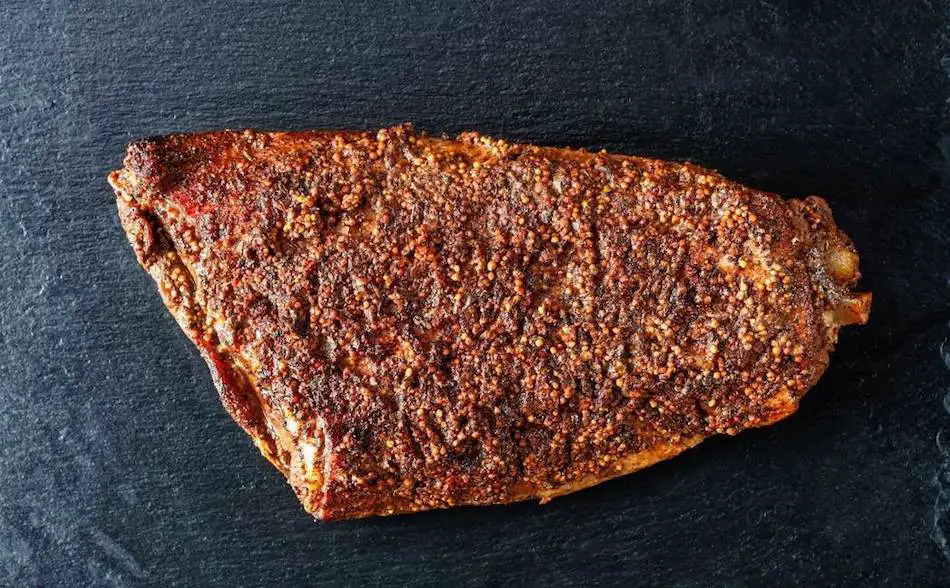
Hot-and-Fast Saves Time
The advantage of the hot and fast brisket is time. I still struggle to get my head around the idea that I can cook a brisket in about 4 hours because it just goes against everything that I have learned over the years about cooking brisket.
It surprised me that a hot and fast brisket could be tasty. I thought it would be tough, chewy, dry and have no flavor. Although it’s not as good as a low and slow brisket, it’s still is delicious.
The hardest thing about cooking a low and slow brisket brisket is time management. If you need your brisket cooked by a certain time, planning the cook is sometimes difficult. An overnight brisket in the Traeger is common practice, but not everyone is comfortable leaving their grill unattended.
At least with a hot and fast brisket, you could fire up your Traeger early in the morning, cook it for 4-5 hours, allow it to rest, then serve at lunchtime. You may not wow your guests as much as you would with a low and slow, but if it’s just a backyard brisket for you and your family, it’s totally fine.
Wrapping the Brisket
- Wrapping is important during brisket cook
- Wrap hot and fast brisket after 1.5 to 2 hours
- Use butcher paper or aluminum foil for wrapping
- Both options will serve the purpose
Wrapping is an important stage of the brisket cooking process, as it helps to hold in the moisture and protect the meat from overexposure to heat. When cooking a hot and fast brisket, it is generally recommended to wrap the meat after about 1.5 to 2 hours of cooking time.
There are a couple of different options for wrapping the brisket, including using butcher paper or aluminum foil. Butcher paper allows the brisket to “breathe” and will help to preserve the bark, while aluminum foil creates more steam and can help to raise the temperature of the brisket. Both options will serve the purpose of wrapping the brisket and helping to hold in the moisture, so you can choose the one that best fits your preferences and needs.
After you have finished wrapping your brisket, insert a thermometer probe into the meat. What Should I Wrap My Brisket In? Paper or Foil?
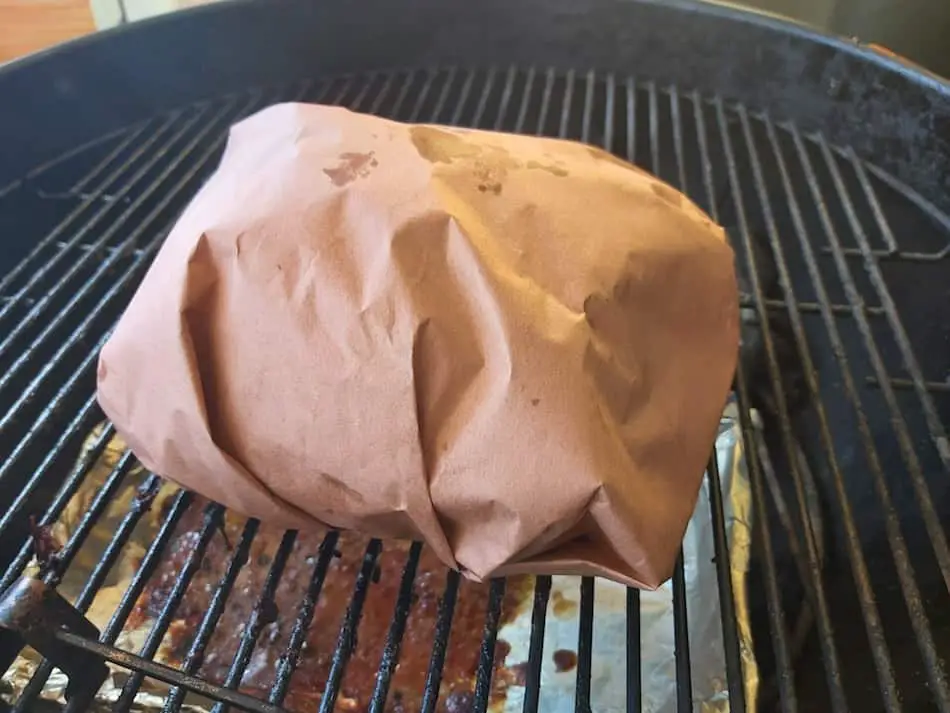
Use a Good Meat Thermometer
- Monitoring internal temperature is critical for hot and fast brisket
- Insert thermometer probe into middle of wrapped brisket
- Check internal temperature and once it reaches around 195°F, use instant-read thermometer to check tenderness
- Brisket is done when meat feels as tender as poking butter
Monitoring the internal temperature of the meat is a crucial step in the process of cooking a hot and fast brisket. Once the brisket is wrapped, you can insert a thermometer probe into the middle of the meat to keep track of the internal temperature. As the meat cooks, you should periodically check the internal temperature and, once it reaches around 195°F, you can start using an instant-read thermometer to check the tenderness of the meat.
The brisket is done when the meat feels as tender as poking butter. This is a good indicator that the fat and connective tissue have rendered and the meat is ready to be served.
Thermometers are extremely important if you want to cook brisket well. Don’t trust the factory thermometers that come with your grills. Always use your own. Check out my Guide To Thermometers to find out why.
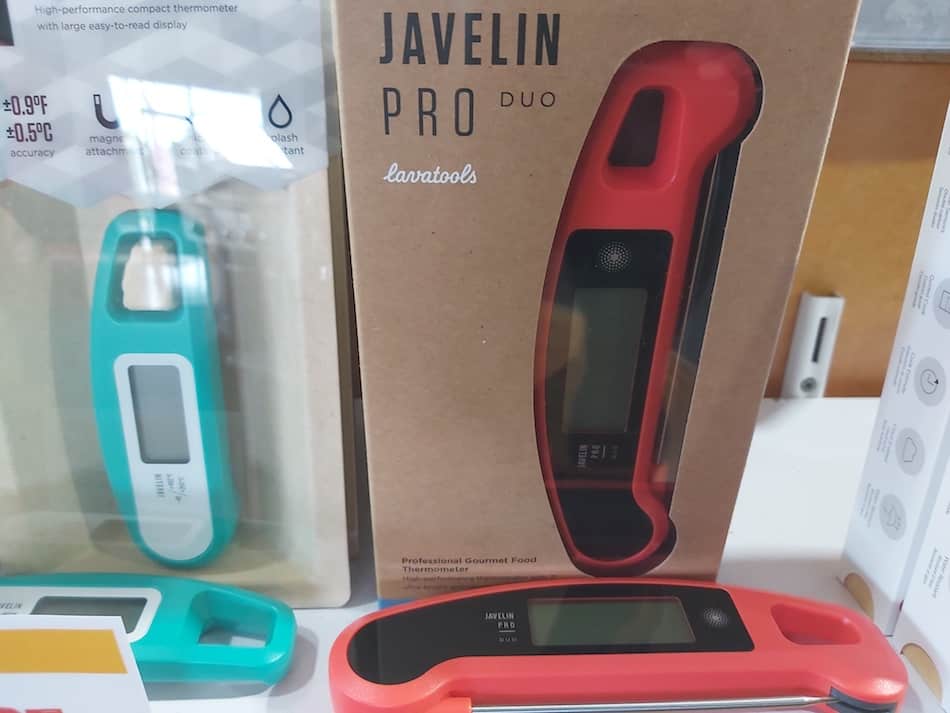
How to Buy a Good Brisket
- Brisket selection at the butcher is one of the most important steps in smoking hot and fast.
- Choose a brisket that has as much marbling as you can afford.
- Select the brisket that has an even layer of fat.
- If you are only smoking the brisket flat, choose one that has some fat underneath.
- A brisket flat can be a little tricky to cook because it is thin and lean. So if your only choice is a flat, at least get one with a nice, even fat covering.
Brisket selection at the butcher is a crucial step in the process of smoking a hot and fast brisket. It is important to choose a brisket that has as much marbling as you can afford, as the fat within the meat will help to keep it moist and flavorful during the cooking process. Look for a brisket that has an even layer of fat, as this will help to ensure that the meat is evenly moist throughout.
If you are only smoking the brisket flat, it is especially important to choose a flat that has some fat covering the underside, as this cut of meat can be thin and lean and may benefit from the added moisture and flavor provided by the fat. Overall, the key to a successful hot and fast brisket is to choose a high-quality cut of meat with a good amount of marbling.
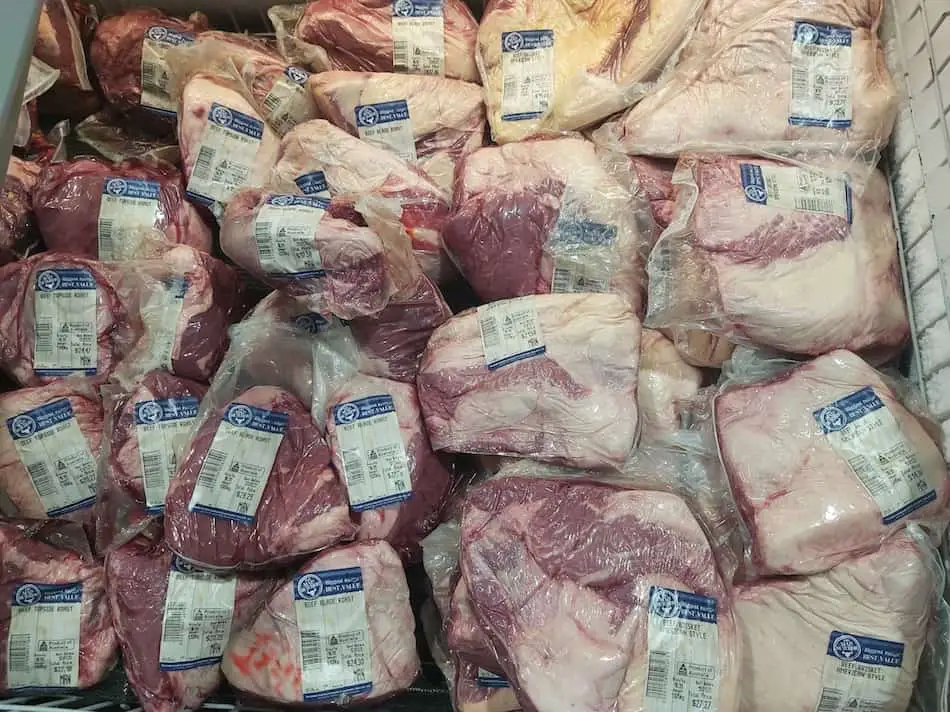
How to Trim a Brisket
- Some fat needed to protect meat from high heat
- Trim fat to 1/4 inch thickness
- Remove silver skin on underside of brisket with sharp knife
- Silver skin does not render and should be removed
When preparing a hot and fast brisket, it is important to have some fat on the meat to help protect it from the high heat of the cooking process. However, most of the fat should be trimmed down to a thickness of about 1/4 inch in order to allow the heat to penetrate the meat more effectively.
To do this, use a sharp knife to remove any excess fat from the surface of the meat. It is also important to remove the silver skin, a thin layer of connective tissue, from the underside of the brisket. This tissue does not render during the cooking process and can result in a chewy texture, so it is best to remove it with a sharp knife before cooking. Trimming the fat and removing the silver skin can help to ensure that your hot and fast brisket turns out juicy and tender.
The Best Rub for Smoked Brisket
A simple brisket rub can be made with just kosher salt and ground black pepper, and you can add in additional ingredients such as paprika, garlic powder, onion powder, or cumin to further enhance the flavor.
When using store-bought rubs, it is important to pay attention to the salt content, especially if you are pre-brining your brisket. Too much salt can result in a overly salty final product, so it is best to use a rub with a moderate salt content or to adjust the amount of rub used accordingly.
I’ve written a full-length article on brisket rubs where I show you where to find all the best home-made rum recipes for brisket, and show you where you can get the best store-bought brisket rubs. You can find the article here.
Standard Barbecue Rub

I found this great rub recipe through How To BBQ Right. I use this recipe and alter it slightly depending on what I'm cooking. Made by the guys at Townsend Spice & Supply: https://townsendspice.com/
Ingredients
- - ½ Cup Paprika
- - ½ Cup Salt
- - ½ Cup Sugar
- - ½ Cup Granulated Garlic
- - ¼ Cup Granulated Onion
- - ¼ Cup Chili
- - ¼ Cup Cumin
- - 2 Tablespoons Black Pepper
- - 2 Tablespoons Dry Mustard
- - 1 Tablespoon Cayenne Pepper
Instructions
- Combine all the spices together in a large mixing bowl
- Store rub in rub shakers
My Favorite Brisket Tools
Thanks for checking out this article. I hope you learned a few things. Here are some of my favorite tools I use when smoking brisket that may be useful to you. These are affiliate links, so if you decide to purchase any of these products, I’ll earn a commission. But in all honesty, these are the tools I recommend to my family and friends who are just starting out.
Meat Injector: Injecting meat is a great way to take your barbecue to the next level and help you make competition-style brisket. An injector is the only way you will be able to get flavor and moisture into the middle of the meat. The Beast Injector is a stainless steel injector that is sturdy and affordable. Check the latest price on Amazon here.
Brisket Marinade: The best injection solution on the market is the Butcher BBQ Brisket Injection. This marinade is used in competitions and is made by World Barbecue Champion pitmaster, Dave Bouska. You can find the marinade on Amazon here.
Butcher Paper: Wrapping brisket in butcher paper has become a huge trend in barbeque thanks to Aaron Franklin. Wrapping your brisket in paper will give you a nice brisket bark. However, you can’t just use any old paper, it has to be unwaxed, food grade paper. You can find it on Amazon here.
Brisket Rub: These days I make my own rub when possible, but I always have a few pre-made rubs for when I’m running low. Barbecue guru Malcom Reed produces Killer Hogs, one of the best brisket rubs I’ve found over the years. Another great rub is Slap Yo Daddy, made by brisket master and multiple World Barbecue Champion, Harry Soo.
Meat Thermometer: There are dozens of fancy thermometers on the market, but I still use my trusty TP20. For around $50, I have a high-quality meat thermometer with two probes, and can track the temperature of my smoker with one probe, and my meat with the other probe. The ThermoPro TP20 is an Amazon Best Seller because it’s the easiest thermometer to operate, is durable, highly accurate, and comes with pre-programmed meat settings.
Instant Read Thermometer: Arguably, the second most important tool you need is a fast and accurate instant-read thermometer. These tools play an important role in the latter stages of the cook when the meat needs regular checking in multiple areas. I use the ThermoPro TP19 because it can do everything a ThermaPen can do, but for a fraction of the cost. You can check out the TP19 on Amazon here.
Advanced Thermometer and Automatic Temperature Controller: Once you’re ready to take things seriously, the FireBoard 2 Drive is a six-channel Bluetooth/Wi-Fi thermometer that can monitor up to 6 pieces of meat, control and graph your cook sessions on your smartphone, and attaches to an an automatic blower that will convert your charcoal smoker to a set-and-forget. This is one of the most advanced meat thermometers on the market. You can check it out on the FireBoard website here.
